Intel Reports Q3 2020 Earnings: Still Very Profitable, But Challenging Times Ahead
by Ryan Smith on October 22, 2020 9:00 PM EST- Posted in
- CPUs
- Intel
- Financial Results
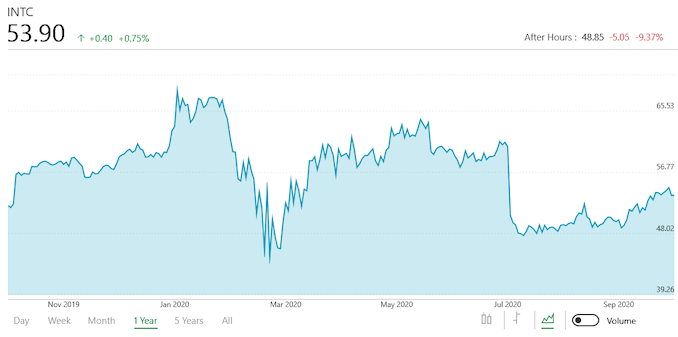
Once again kicking off our earnings season coverage for the tech industry is Intel, who reported their Q3 2020 financial results this afternoon. The traditional leader of the pack in more than one way, Intel has been under more intense scrutiny as of late, particularly due to their previously disclosed delay in their 7nm manufacturing schedule. None the less, Intel has been posting record revenues and profits in recent quarters – even with a global pandemic going on – which has been keeping Intel in good shape. It’s only now, with Q3 behind them, that Intel is starting to feel the pinch of market shifts and technical debt – and even then the company is still well into the black.
For the third quarter of 2020, Intel reported $18.3B in revenue. A drop of $0.9B over the year-ago quarter. As previously mentioned, Intel has been setting a string of record revenues in previous quarters, but the boom is coming to an end as margins and revenues are slipping. Those declines are also having the expected knock-on effect to Intel’s profitability, with the company reporting $4.3B in net income, a 29% drop versus Q3’19.
This also marks the second quarter where Intel’s overall gross margin has been noticeably soft. The company, normally known for its zeal for 60% margins, recorded a margin of just 53.1% for Q3, following last quarter’s 53.3%, and 58.9% a year ago. The drop in gross margins is a big part of Intel’s financial story for the most recent quarter: according to the company, average selling prices (ASPs) are down as customers gravitate towards cheaper products, and meanwhile costs are up as Intel further ramps up its 10nm plans.
| Intel Q3 2020 Financial Results (GAAP) | |||||
| Q3'2020 | Q2'2020 | Q3'2019 | |||
| Revenue | $18.3B | $19.7B | $19.2B | ||
| Operating Income | $5.1B | $5.7B | $6.4B | ||
| Net Income | $4.3B | $5.1B | $6.0B | ||
| Gross Margin | 53.1% | 53.3% | 58.9% | ||
| Client Computing Group Revenue | $9.8B | +4% | +1% | ||
| Data Center Group Revenue | $5.9B | -17% | -8% | ||
| Internet of Things Group Revenue | $677M | +1% | -33% | ||
| Mobileye Revenue | $234M | +60% | +2% | ||
| Non-Volatile Memory Solutions Group | $1.2B | -31% | -11% | ||
| Programmable Solutions Group | $411M | -18% | -19% | ||
Breaking things down on a group basis, the majority of Intel’s internal reporting groups have seen revenue declines over the year-ago quarter. Though still not Intel’s largest segment, their data center group has been the company’s biggest star over the past year and a significant source of revenue. But revenues have begun slipping there, and for Q3’20 Intel booked $5.9B, which is down 8% from last year. Driving this decline has been a drop in ASPs, which dropped 15% versus the year-ago quarter. Breaking this down, Intel cites a significant drop in enterprise and government sales, coupled with a jump in 5G SoC sales that are dragging down the average.
As for Intel’s client computing group, revenues have held just slightly better than steady, growing 1% over last year. Still Intel’s largest group by revenue, client computing has been the most exposed to changes in buying habits from the coronavirus shift, which is represented in Intel’s revenue mix. Desktop sales are down and notebook sales are up; unfortunately notebook ASPs are down, handicapping the revenue gains there. Overall Intel is reporting that customers have shifted to less expensive processors, which has driven the revenue declines.
Meanwhile the biggest loser for Intel in Q3 has been their IoT group, which saw a 33% drop in revenue as Intel was impacted by both the pandemic and new US government export restrictions. Its counterpart Mobileye fared better, however, with revenue growing 2%.
Finally, Intel’s Non-Volatile Memory Solutions Group has been a hot topic this week, and is so again today. The group, which covers Intel’s NAND and Optane businesses, saw its revenue decline 11% versus Q3’19. According to the company ASPs are up versus this time last year, but not enough to cover a decline in total volume.
The marginally profitable group is about to undergo a split, as Intel slices out the NAND side of the business and, pending government approval, sells it to SK Hynix. The unstable, commodity nature of NAND has vexed Intel in recent years, so the company is letting go of the business in order to focus on more profitable opportunities elsewhere. Still, Intel won’t be fully divested of the business until 2025, so it will remain a part of Intel for years to come. In the meantime, the company had very little to add about the transaction in today’s earnings announcement; since Intel is the seller, the initiative to discuss the deal lies with the buyer, SK Hynix.
Overall, Q3 marked another very profitable quarter for Intel. But it’s also clear that the company is going to face some new and recurring challenges over the coming quarters, and may not be out of the woods until 2023, if not later. The biggest drag being their 7nm delays, which have seen Intel’s initial shipments pushed out to at least the end of 2022, if not later. These delays have also led to Intel looking at outside foundries (e.g. TSMC) to make up the difference, which will likely hurt Intel’s margins and leave the company fighting with other fab customers for supplies. For this reason Intel is still hoping to leverage its own 7nm fabs first and foremost, though the company doesn’t expect to make (or at least, report) its most critical decisions there until early 2021.
In the meantime, Intel has further ramped up its 10nm capacity (which wasn’t the original plan) in order to meet their needs over the next couple of years. According to the company, Intel now has 3 10nm fabs, following the recent addition of a 10nm fab in Arizona. As a result it has more capacity to handle 10nm products such as their recently-launched Tiger Lake CPUs, with Intel stating that they now expect to ship 30% more 10nm chips this year than their original plans from January of 2020 called for.
Unfortunately, Intel’s overall product mix remains in an odd spot, especially on the data center side of matters. Previously Intel has stated that Ice Lake Server (Ice Lake-SP) would start production shipments this year. And while this has technically changed, Intel has now clarified this to mean that qualification is only now taking place at the end of Q4, with volume ramps to start in 2021. Intel’s continued reliance on 14nm Skylake-based cores has been an albatross around the company’s neck, and the company badly needs a 10nm server product to improve the number of cores per CPU they can ship. However at the rate things are going, Ice Lake Server may very well end up being a short-lived part; if Intel’s Sapphire Rapids remains on schedule, the 10nm Enhanced SuperFin-based part is supposed to ship in 2021.
Speaking of future products, Intel has also confirmed that they’re now sampling Alder Lake, which will be their 2021 client CPU. Intel’s first x86 hybrid CPU, the company has previously said that it will be for both desktops and mobile, and it will also be built on their 10nm Enhanced SuperFin process. With that said, Intel traditionally samples new parts well in advance – especially for parts that will lead to major platform changes – so this shouldn’t be taken as a sign that Alder Lake is anything sooner than a Q3/Q4 2021 product.
In the interim, Intel is likely to face some of the stiffest competition in at least a decade, if not more. AMD and several Arm customers are eyeing Intel’s client and server market share (and associated profits) with their improved products, and while the company continues to talk up its own products, it's increasingly clear that they don't expect to be able to return to their traditional leadership position until at least 2023. So for now, with Intel still working to adapt to their newfound flexible fab strategy, combined with finally correcting a troubled 10nm process, it’s clear that after a long period of record revenues some challenging times are ahead for the company.
Source: Intel


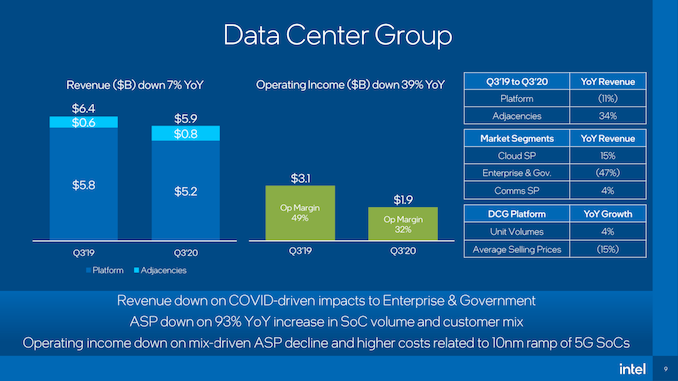
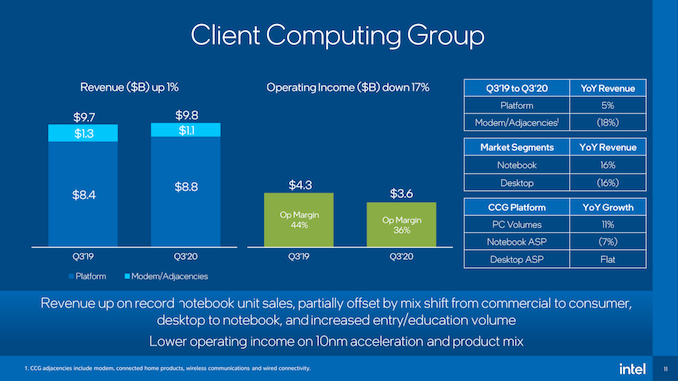
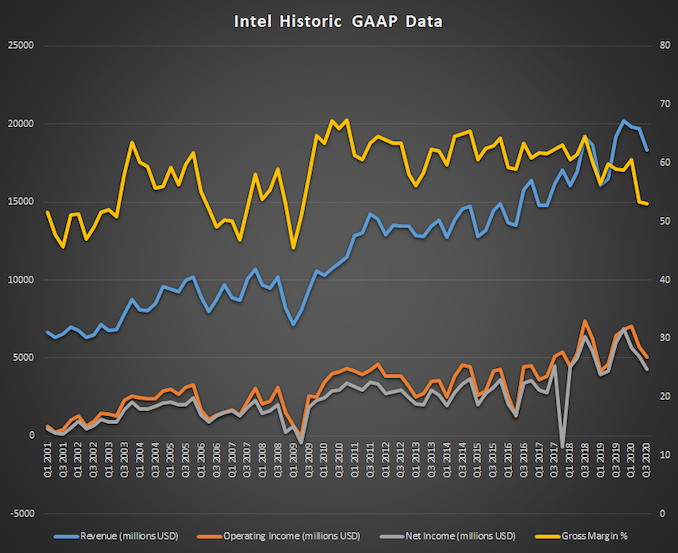
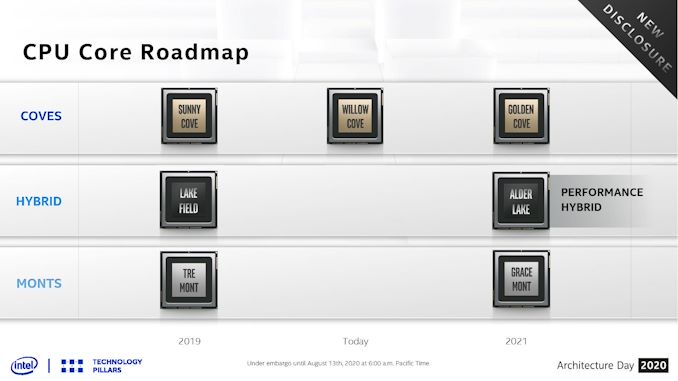
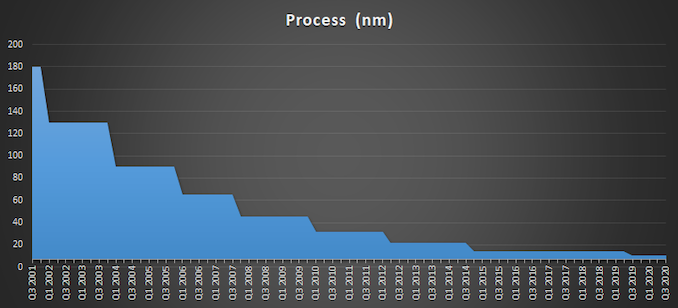








27 Comments
View All Comments
mdriftmeyer - Friday, October 23, 2020 - link
Data Center revenues are now going to AMD. Data Center growth is expanding, not shrinking and people are moving away from Intel.AshlayW - Saturday, October 24, 2020 - link
People still buy intel products?Qasar - Saturday, October 24, 2020 - link
yes, because amd will charge too much for their, what looks like, better performing ryzen 5000 cpus.Showtime - Saturday, October 24, 2020 - link
Bought 4x intel 9700k for various builds this week. $200 each on sale. Can't beat it. Always comes down to price vs performance. All Intel has to do is lower prices a bit, and they will sell well enough. New AMD's are $300 for their 5600x 6 core. Shouldn't be too hard for Intel bring the new 11600k for less if needed. If AMD came in at a $200 for their new 6 core like they were for the old one, then Intel would be in trouble.Calin - Monday, October 26, 2020 - link
After all, AMD is competing in the GPU market with what is basically a higher powered (in Watts), cheaper GPU versus NVidia.Calin - Monday, October 26, 2020 - link
I don't think AMD is able to produce enough processors, so somebody must take up the "rest of the market"K_Space - Sunday, October 25, 2020 - link
"The drop in gross margins is a big part of Intel’s financial story for the most recent quarter: according to the company, average selling prices (ASPs) are down as customers gravitate towards cheaper products..."Cheaper products? Ahahaha; is that their way of saying: we were ripping customers off before but now can't sustain our ridicilous pricing because we have real and viable competition.